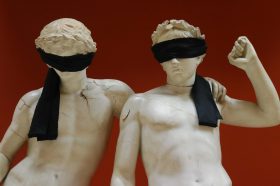We live in polycrisis times. In post Voice referendum “Australia”. In the midst of visible local and international legal and human rights abuses. In a decimated sector impacted by an ongoing pandemic, cost of living, climate and mental health crises, and more.
All of which have raised awareness of and reduced tolerance for things we’ve always known. Things we’ve articulated and have been trying to change – if incrementally – through endless research papers, consultations and planning days.
Including that, in the main, our organisations and sector are not accessible, equitable, representative or culturally safe (and are, in fact, becoming less so). That these issues are systemic and deeply embedded, and reinforced by governance, business and funding models that rely on us to do too much with too little in ways that compromise people and outcomes.
All of which means change is slow, inequities persist, and we are often unready and ill-equipped to respond when things happen – particularly when they happen fast, on multiple fronts, and in areas outside of our expertise.
In this article:
Key deficits
It seems almost everyone is experiencing some level of brokenness or burnout at the moment. In the microcosm, the arts and cultural sector is being torn apart by austerity and precarity, poor governance, risk and crisis management practices, and even worse interpersonal behaviours. Unsurprising, perhaps, given that unfamiliar, shocking or previously unimaginable situations often prompt individuals and organisations to respond in unfamiliar or shocking or previously unimaginable ways.
But, regardless of how they’ve been motivated or justified, our news and social media feeds are currently overflowing with arts organisations fumbling and failing their artists, audiences and stakeholders. These examples have identified a number of recurring sector deficit areas, including:
- a lack of general governance readiness for when things start to go wrong
- poorly articulated organisational ethics and values that don’t hold up when put to the test, and
- the decimation of formal and information ways of being with and communicating with each other.
Read: Exploring the ethics of Artificial Intelligence in art
Opportunity to review
Art and culture have traditionally been ways we have brought people together and held space for new and challenging ideas, moved conversations forward, shifted paradigms, changed minds and even saved lives. But with the people that make or engage in those processes more depleted, and the state of our sector more tenuous than many of us have ever known, how do we hold and care for those who do the work of holding and caring for others?
How do we re-centre our commonality and shared humanity, without being dismissive of recent and ongoing hurt? How do we create safe spaces for honesty and multiplicity alongside civility and respect?
Most organisations articulate agreed, collective values as part of their strategic plans, codes of conduct, ethical frameworks or other policy and partnership documents. Unfortunately, not many of them are proving to be as robust as we’d hoped from the well-catered theoretical musings of past planning days.
Which means we need to take this opportunity to review and ask questions like: who set those values in the first place, and how? Who was in the room and who was excluded (either intentionally or accidentally)? Whose voices do we now need to represent? And which, if any, of our stakeholder groups will we prioritise, in what circumstances? Who will we listen to during times of conflict: the largest group, the loudest, those closest to our purpose or those under our duty of care?
Our news and social media feeds are currently overflowing with arts organisations fumbling and failing their artists, audiences and stakeholders.
Furthermore, what do those values actually look like on the ground? How do we embed them into our governance, operations, communications and decision-making? How do we review, refine and recommit to our organisational values to make sure we practise what we preach?
Starting small
It’s important to remember that there is no precedent for this polycrisis in most of our careers, no experts, no formula for making sure our responses get it right.
Which is why it’s hard to imagine what our sector will look like if and when we get to the other side – to imagine when healing may be possible and what scars may be left behind.
But it’s likely that our efforts will need to start small and hyper-local. By making space to ask these sorts of values-based questions at board level, in boards’ pastoral care of CEOs, or within staff and artistic teams, before broadening them out to other stakeholder groups. By proactively reducing board and staff workloads in order to have those conversations properly. And by rearticulating our organisational values and what they actually mean: how they inform what we do and how we do it, the decisions we make and who makes them.
Read: Predictions for the arts canon in 2050
Otherwise, no matter how many times we say “First Peoples First”. “inclusion good” or “racism bad” or tick another box on our Diversity Access and Inclusion Plans, if we don’t walk the talk around organisational ethics, equity and cultural safety, our organisations will continue to deepen those deficits, not reduce them.
A version of this article was originally published on Kate Larsen’s ‘And Another Thing’ vlog.





